Other pages of research for
this feature:
www.tampapix.com/zacchini2.htm
www.tampapix.com/zacchinicensus.htm
www.tampapix.com/pagnotta.htm
www.tampapix.com/linkschrono.htm
www.tampapix.com/vitalstats.htm
This feature is only in the info gathering phase and organization phase.
Mario Zacchini, Sensational Human Cannonball, Dies at 87
By GLENN COLLINS
Published: February 3, 1999
http://www.nytimes.com/1999/02/03/arts/mario-zacchini-sensational-human-cannonball-dies-at-87.html
Mario A. Zacchini, the last surviving member of the original generation of human
cannonballs, whose routine employment was being explosively propelled from a
cannon across a circus tent into a net, succumbed to old age on Thursday at St.
Joseph's Hospital in Tampa, Fla. He was 87 and lived in Tampa.
Mr. Zacchini, who was customarily launched at a speed of 90 miles an hour while
accompanied by a fanfare from the circus band and a roar from the silver-painted
cannon, took flight several thousand times, usually three times a day.
He often said that ''flying isn't the hard part; landing in the net is.''
Mr. Zacchini was the next-to-youngest son of the nine children of Ildebrando
Zacchini, a gymnast who ran away with a circus and subsequently created the
Circus Olympia in Italy in the early 1900's.
Eventually five of the seven brothers flew from a cannon; Mario was the last
survivor of the nine children.
In addition to being three-ring cannon fodder, he spent years performing an
Argentine gaucho act in his father's circus and later in the Ringling Brothers
and Barnum & Bailey Circus.
''Mario was one of the world's most foremost rope twirlers, a terrific gaucho
who actually did a back somersault through the lasso,'' Mario's nephew Hugo said
in an interview.
Hugo Zacchini said the family came up with the idea for the act and built its
first cannon in 1922 on the island of Malta. The attraction created such a
sensation that soon two teams of flying Zacchinis were crisscrossing Europe.
John Ringling discovered the Zacchinis performing in the Tivoli Gardens in
Copenhagen and brought them to the Ringling Circus by 1929, the nephew said. Two
of Mario's older brothers, Bruno and Hugo, introduced the human cannonball act
to the Ringling show.
In 1934, Hugo and another brother, Victor, began performing a double cannonball
act, being catapulted nearly simultaneously. Mario put aside his lasso to
replace Victor that year.
After the Zacchini family's contract with Ringling expired in the late 1930's,
Mario Zacchini continued to be a human cannonball at circuses and carnivals and
at the World's Fair in New York. At times he was blasted over two Ferris wheels
before landing in the net. He retired from cannoneering in the early 1940's and
put together his own carnival, which toured the country for years.
A decade later the next generation of Zacchinis took up human cannonballing,
performing with the Ringling circus from 1958 to 1963, said the nephew Hugo, In
1965 there were five different Zacchini cannon acts performing around the United
States. Hugo, who is a son of Mario's brother Edmondo, said he was the last
Zacchini to be a human cannonball; his final flight was on Aug. 29, 1991.
While the Zacchinis always acknowledged that their shattering cannon blasts were
purely sound effects (achieved by igniting half a cup of black gunpowder), Mario
and his family never revealed the secret of the Zacchini launching mechanism, to
deter copycats.
But other circus performers have said that the propulsion was accomplished by a
jolt of compressed air that moved a platform upon which the performers stood.
These days, many human cannonballs from other circus families are launched with
elastic bungee cords.
Mario Zacchini is survived by his wife, Lydia; a daughter, Yvonne, and two sons,
Mario Jr. and Tyrone, all of Tampa.
From Wikipedia:
http://en.wikipedia.org/wiki/Hugo_Zacchini
Hugo Zacchini (20 October 1898 – 20 October 1975) was the first human cannonball
as one of the Zacchini Brothers. His father Ildebrando Zacchini invented the
compressed-air cannon used to propel humans in circus acts. He was known for
being a daredevil and a painter. He was born on October 20, 1898 in Peru to
Ildebrando Zacchini. He held two engineering degrees from the University of
Florida.
Born October 20, 1898
Peru, South America
Died October 20, 1975
San Bernardino, California
Education University of Florida; Attended Rome Arts Academy where at age of 12
he graduated. Graduated Jamestown Academy in New York, where he received a
Master's in Art.
Occupation Daredevil and artist, sculptor, taught art in Chaffey College,
interpreter to as many as 11 languages.
Spouse(s) Elsa Gertrude Walker Zacchini
Children Hugo Anthony Zacchini, Patchay "Pat" Zacchini
Photo: File:Edmondo Zacchini and Hugo Zacchini 1960-1970 circa.jpg
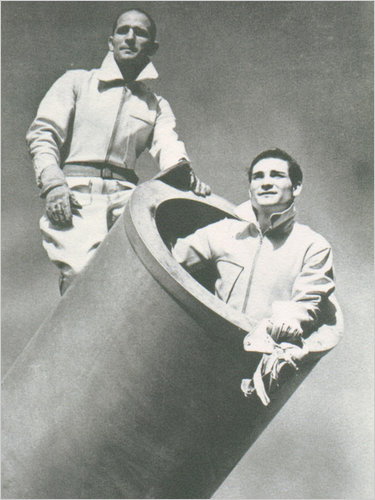
"Edmondo Zacchini, Inventor Of Human Cannonball Act, 87". Associated Press in
New York Times. October 7, 1981. Retrieved 2008-08-04. Edmondo Zacchini,
credited with inventing the Human Cannonball circus act by firing himself out of
an spring-powered cannon, died here in a hospital Saturday. He was 87 years old.
Mr. Zacchini developed his act in Cairo in 1922 using a crude spring-powered
cannon that hurled him 20 feet. He later developed one using compressed air.
The first time he was shot from the cannon, he broke a leg and redesigned the
device in the hospital. Mr. Zacchini and his brother Vittorio came to the United
States in 1930 at the invitation of a circus promoter; eventually the family
settled here. Their act involved six brothers and two sisters.
http://www.nytimes.com/1999/02/03/arts/mario-zacchini-sensational-human-cannonball-dies-at-87.html
http://flashbak.com/i-am-a-human-cannonball-a-brief-history-of-circus-bullets-25160/
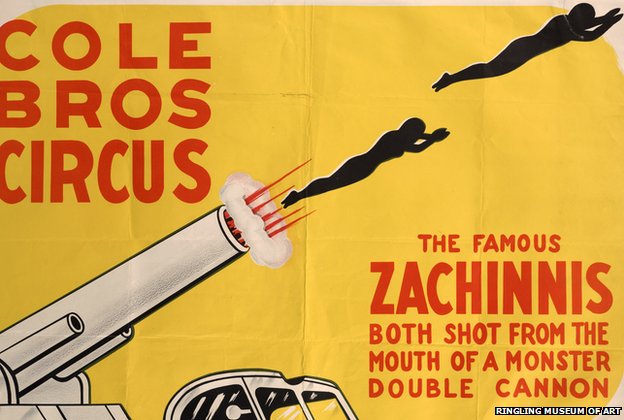
Hugo Zacchini of Turin, Italy, is shot from a specially built cannon invented by
his brother, July 19, 1927. He landed in a net about 130 feet away. (AP Photo)
Ref #: PA.16860983
Date: 19/07/1927
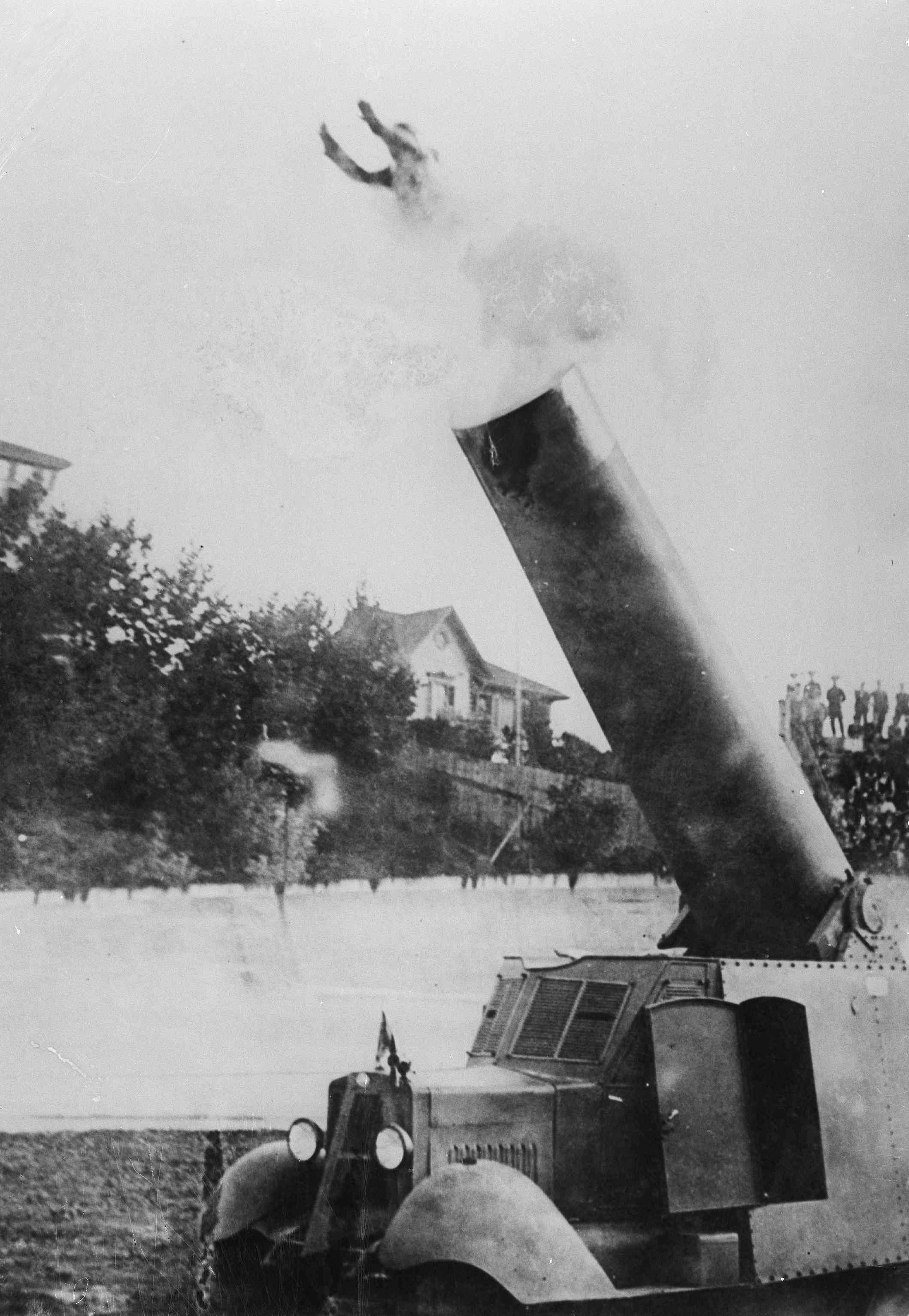
Photo: The Zacchini family have been catapulting members of their family, by use
of a real charge of powder, since the 1920s. Here, one of the Zacchini girls,
Duina is shot from a specially built mortar to a net some 100 feet away, Jan.
13, 1943 (AP Photo)
Ref #: PA.16860989. Date: 13/01/1943
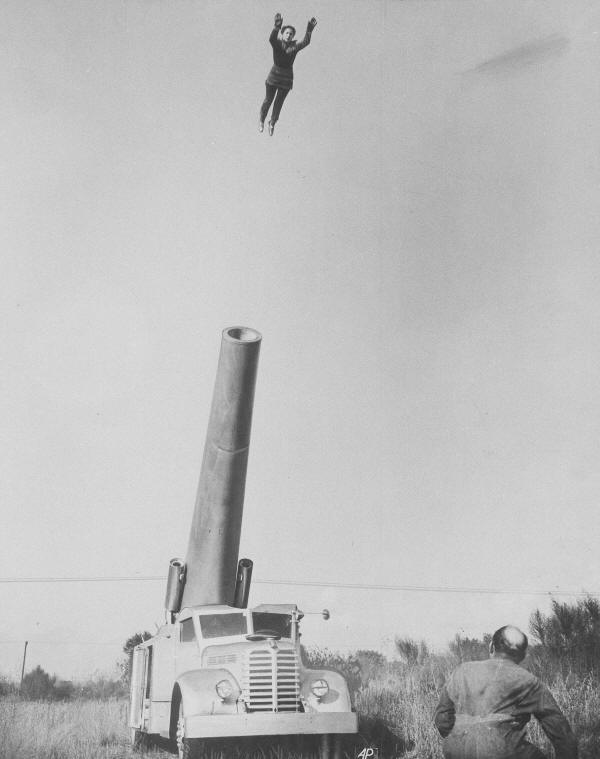
Then in the early 1920s the Zacchinis, an Italian family who moved to America,
revitalized the act with the introduction of a double cannon which fired two
human cannonballs. Their shows sometimes involved as many as six brothers and
two sisters.
But in 1940, one of the brothers, Mario, was forced to retire after an accident
at the New York World’s Fair. Thirty years later, his niece Linda broke her neck
after colliding mid-air with her husband Emanuel.
Photo close up of truck - Circus star G. Hugo Zacchini, famous for 30 years as
“The Human Cannonball”, prepares to climb into the mouth of his cannon during
his act in a circus at Palisades Park, N.J., April 11, 1958. Zacchini, who is
shot into space twice a day, now is billed as “The Human Satellite.” The altered
billing reflects his new aim in life – a trip in a rocket. Zacchini is convinced
that only a cannon man, used to looking upon life as a bore, is mentally and
physically equipped for a space journey. (AP Photo/Matty Zimmerman)
Ref #: PA.16860988.

Circus star G. Hugo Zacchini, famous for 30 years as “The Human Cannonball”,
prepares to climb into the mouth of his cannon during his act in a circus at
Palisades Park, N.J., April 11, 1958. Zacchini, who is shot into space twice a
day, now is billed as “The Human Satellite.” The altered billing reflects his
new aim in life – a trip in a rocket. Zacchini is convinced that only a cannon
man, used to looking upon life as a bore, is mentally and physically equipped
for a space journey. (AP Photo/Matty Zimmerman) Ref #: PA.16860991 Date:
11/04/1958
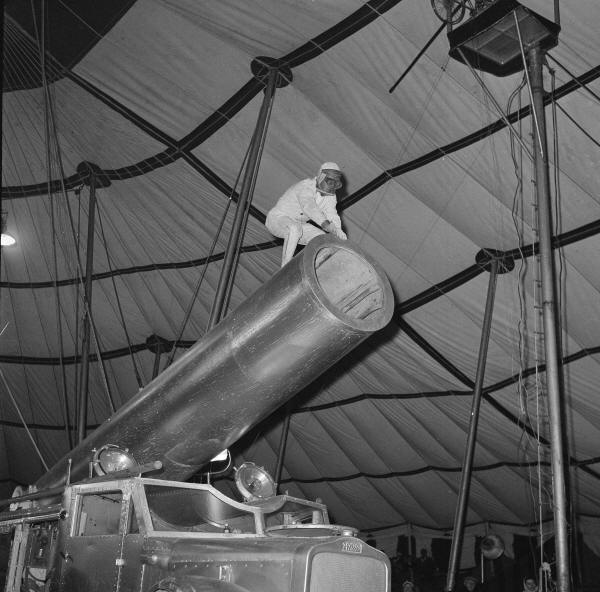
Photo A member of the Zacchini family glides gracefully through space – inside a
tent of the Ringling Brothers circus – after being fired from a cannon in the
grand finale of the show at Nashville, Tenn., March 2, 1962. The human
cannonball arches his back and appears to have lost his head as he prepares for
a landing in the net. (AP Photo)
Ref #: PA.16860995
Date: 02/03/1962
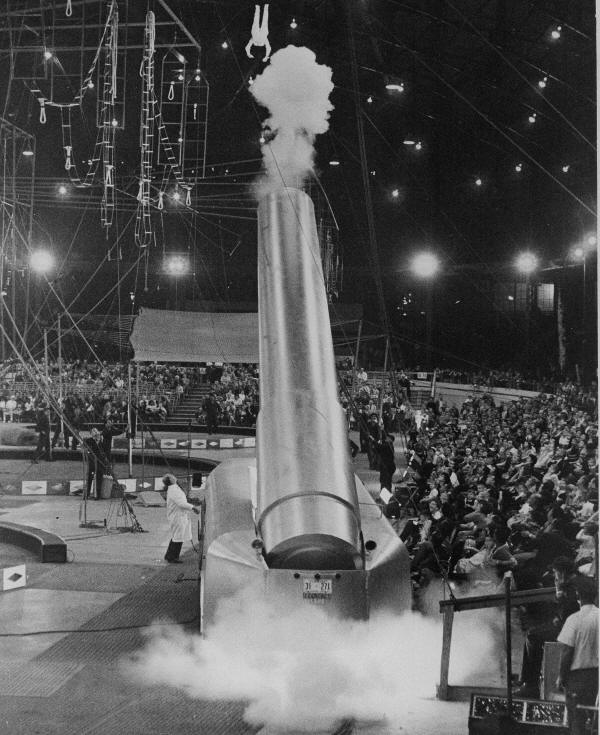
Photo: Emanuel Zacchini bursts from a cannon barrel for an airborne trip across
New York’s Madison Square Garden during a performance of Ringling Bros. & Barnum
and Bailey Circus, April 9, 1970. Zacchini returned recently to the act after
being sidelined by injuries when he collided with his wife during a performance
in Jacksonville, Fla., Feb. 4. Mrs. Zacchini is still in a wheelchair. (AP
Photo/John Lent)
Ref #: PA.16860984
Date: 09/04/1970
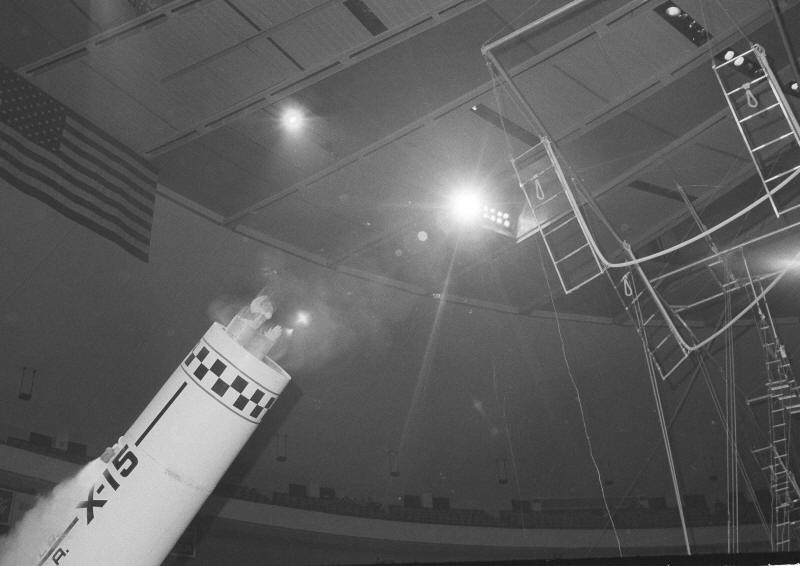
Photo Stuntman Hugo Zacchini (top) is shot out of a cannon into a net (bottom)
to deliver the first ball in Houston’s Astrodome, April 8, 1977. It was the
season opener for the Houston Astros and the Atlanta Braves. (AP Photo/JKW)
Ref #: PA.16860992
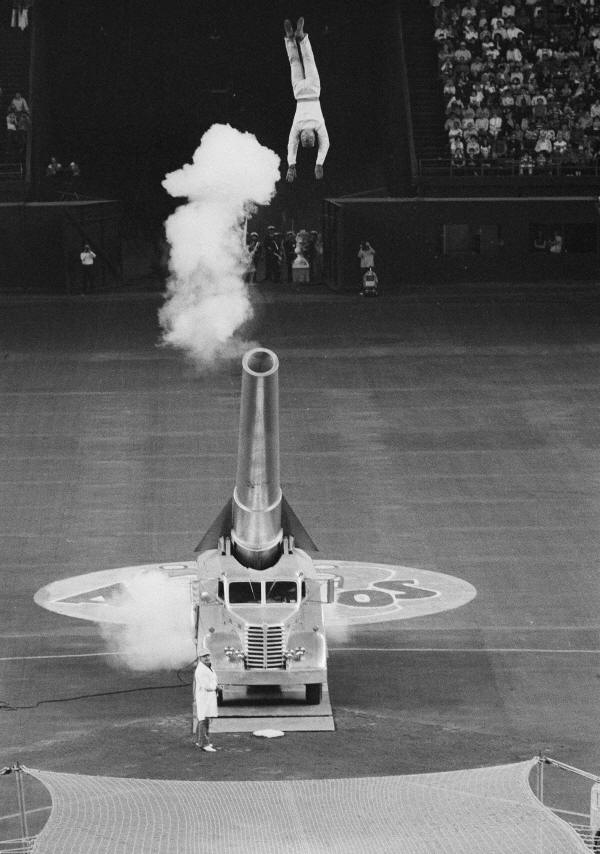
Photo Hugo Zacchini’s act included a flight over two and sometimes three Ferris
wheels
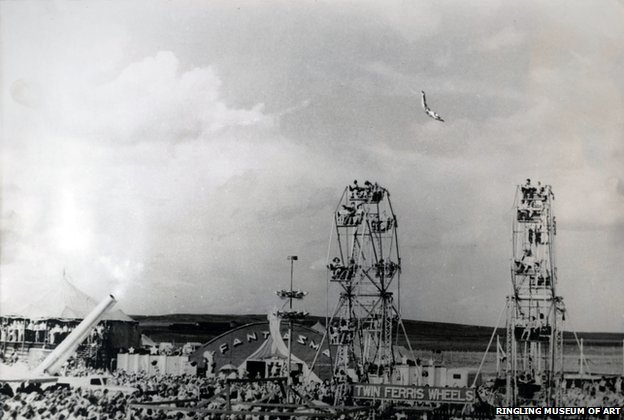
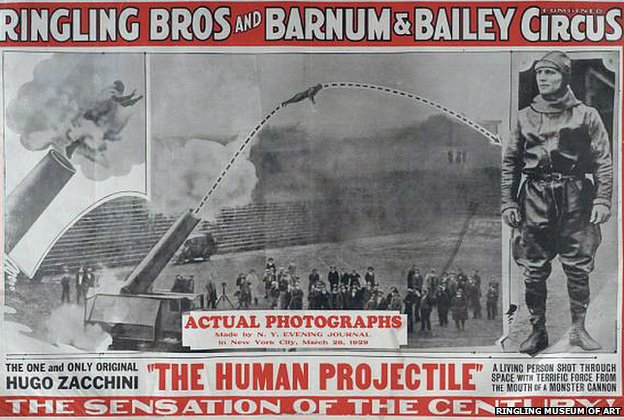
MENTALFLOSS.COM
The cannon's design was upgraded in 1922 by Italy's Zacchini Brothers, who
replaced the rubber springs with compressed air. Originally, they suggested the
Italian Army use the cannon to send troops equipped with parachutes behind enemy
lines, but when the Army said no, they adopted it for the circus instead. Over
the course of 70 years and multiple generations, the Zacchinis became the
long-standing holders of the world record for distance, and helped popularize
the now-common stunt of launching over obstacles, such as buildings or carnival
rides.
Zacchini Human Cannonball movie trailer
https://www.youtube.com/watch?v=HSizGn8vbFQ
Circuses and sideshows dot com
Hugo Zacchini
Oct. 20 1898 – Oct. 20 1975
Cannon act
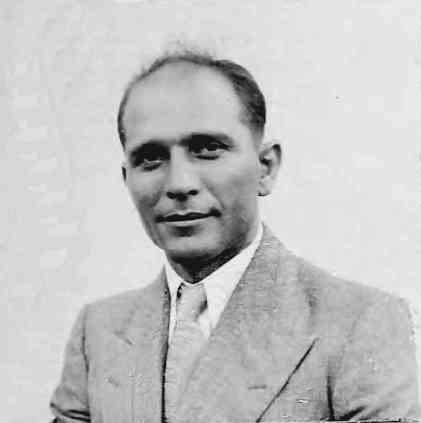
Hugo Zacchini cannon act
Click to enlarge
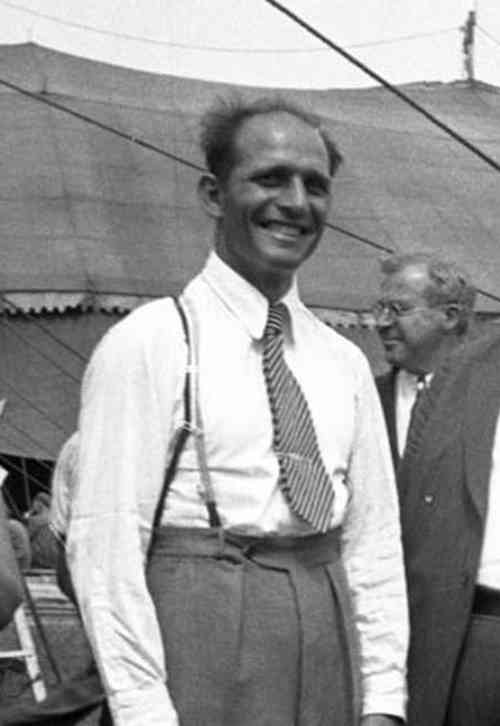
Hugo Zacchini entering cannon 1948
Click to enlarge
Hugo entering the cannon in 1948
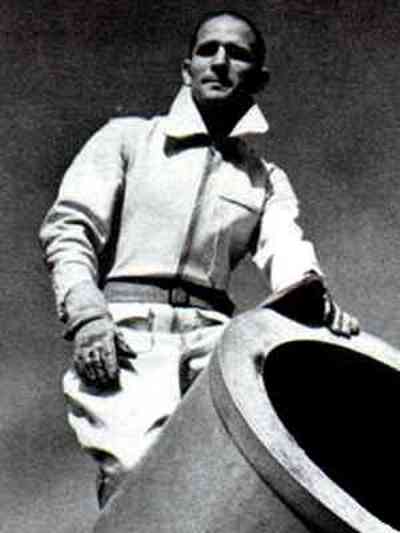
Hugo Zacchini was born on October 20, 1898 in Santa Ana, Peru to Maddalen and
Ildebrando Zacchini. The Zucchini family of Italy, had performed in circuses for
countless generations. Hugo's father's circus was touring Peru at the time of
Hugo's birth. Hugo grew up on his father's circus, where he learned to perform
Juggling, trapeze and many more circus acts.
The famous Zacchini cannon was designed in 1922 by Hugo's father Ildebrando,
with the help of Hugo and his brothers Edmondo and Bruno. The cannon act was
first performed publicly, on the Zacchini Circus while performing in Egypt.
In1928 while Hugo was performing his cannon act in Copenhagen, Denmark, he was
noticed by John Ringling North who immediately offered Zacchini a contract with
the Ringling Bros. and Barnum & Bailey Circus. Hugo remained with the RBBB as a
featured attraction for ten years.
On Feb 12 1930 Hugo married Elsbeth, born in Berlin Germany on February 11 1909.
In 1948 Hugo Zacchini appeared with the "Mighty Hoosier State Shows" an Indiana
based carnival owned by W. R. Geren., where he was shot over two Ferris Wheels
set side bye side an incredible feat (see photo below left).
Although better known as the "human cannonball", Zacchini was also an
accomplished artist, his paintings are greatly sought after today. Hugo became
friends with Pablo Picasso and Salvador Dalí. Hugo had studied art at the Rome
Arts Academy in Italy and received a Master's in Art degree from Jamestown
Academy in New York. Hugo also held two engineering degrees from the University
of Florida.
On October 20, 1975, at age 77 Hugo Zacchini died of a stroke in San Bernardino,
California.
Zacchin's painting of
Lillian Leitzel's entrance into Heaven.
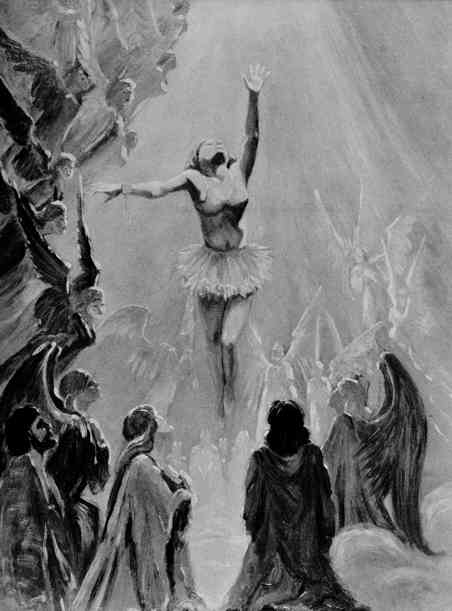
THURSDAY, DECEMBER 14, 2006
IN MEMORY OF DUINA ZACCHINI NORMAN
DUINA ZACCHINI NORMAN #1 THE TRAPEZE FLYER
The Circus World has lost another great Star. I have received word that Duina
Zacchini Norman passed away yesterday, she was an accomplshed Flying Trapeze
Artist and one of the Zacchini Family Human Cannonballs.
Photo: Duina, with brother Eddie, & catcher George Alvarez.
http://yesterdaystowns.blogspot.com/2006/12/in-memory-of-duina-zacchini-norman.html
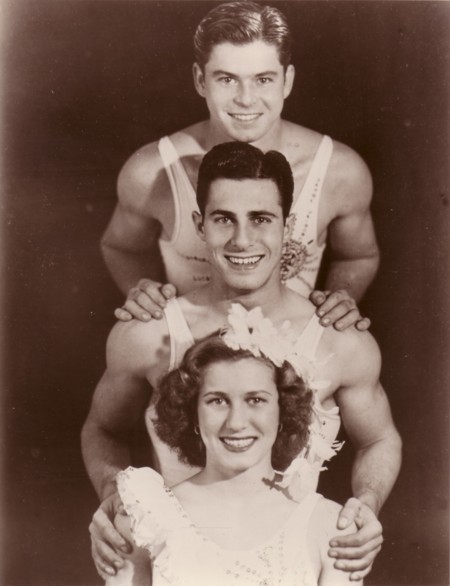
New York Sun:
http://www.nysun.com/obituaries/duina-zacchini-82-human-cannonball/45342/
Duina Zacchini, who died Saturday at 87, found fame as half of a sister act of
human cannonballs, flying 150 feet into a net. Usually, as the Zacchinis were a
family act, the cannoneer was her own father, Edmondo.
The Zacchini family, proprietors of the Italian Circus Olympia, is generally
credited with developing the human cannon. Edmondo Zacchini is said to have
broken his leg on being shot for the first time from the spring-loaded
contraption, in 1922. While still in traction, he redesigned it to use steam
power.
The American circus impresario John Ringling spotted the Circus Olympia's human
cannoneering at Tivoli Gardens in Copenhagen. He brought the act back to America
in 1929, and the Zacchinis moved to America permanently in the early 1930s.
Edmondo used his sons as his primary projectiles for many years. When the sons
enlisted in the armed forces during World War II, Edmondo trained his daughters
to be cannon fodder. Duina Zacchini and her sister Victoria were billed as "The
Zacchini Sisters" and often toured with the Ringling Brothers and Barnum &
Bailey Circus.
They appeared on television shows while dressed in their protective suits and
were celebrity spokesmen for Quaker Puffed Wheat — a product that is created in
a cannon shot-like process.
It was a double life for Duina, touring for two months a year while raising a
family in Nashville, Tenn., where she lived with her husband, a lawyer. "I keep
saying each year, this will be my year to retire," she told the United Press in
1958. "But I don't know. I like to be with my family and I like to be with show
people. We say we have sawdust in our eyes." A life expert in protecting fragile
things, she eventually retired and opened an antique shop.
Find a Grave: http://www.findagrave.com/cgi-bin/fg.cgi?page=gr&GRid=10519871
Egle Victoria Zacchini Sedlmayr
Birth: Aug. 27, 1921
Tunis, Tunisia
Death: Nov. 23, 2001
Tampa
Hillsborough County
Florida, USA
Eldest child of Edmondo and Josephine Zacchini of the Zacchini cannonball fame.
Known as "Miss Victory" during WWII. Performed the double cannon act with her
sister Duina. Married Carl J. Sedlmayr Jr. in 1952 of Royal American Shows

http://www.gettyimages.com/detail/news-photo/egle-victoria-zacchini-and-duina-zacchini-wearing-their-news-photo/50449647
Photo: Duina Zacchini;Egle Victoria Zacchini
Egle Victoria Zacchini (R) and Duina Zacchini wearing their human cannon ball
costumes. (Photo by Ed Clark/The LIFE Picture Collection/Getty Images)
LIFE Magazine article:
https://books.google.com/books?id=d0EEAAAAMBAJ&lpg=PA111&dq=zacchini&pg=PA111#v=onepage&q=zacchini&f=false
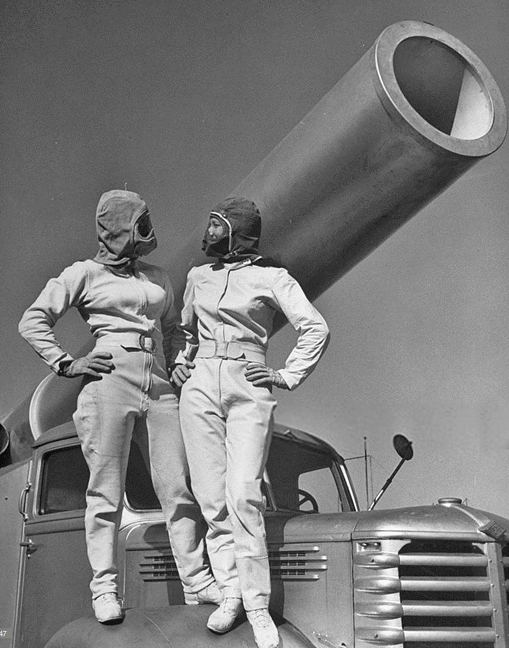
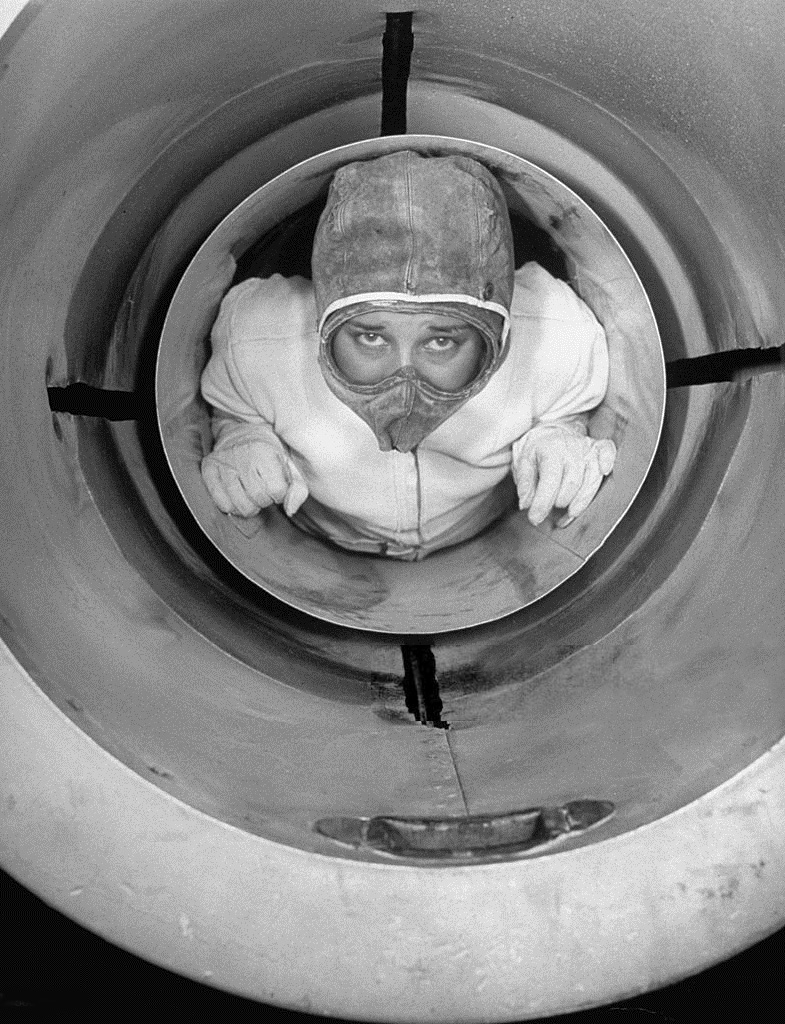
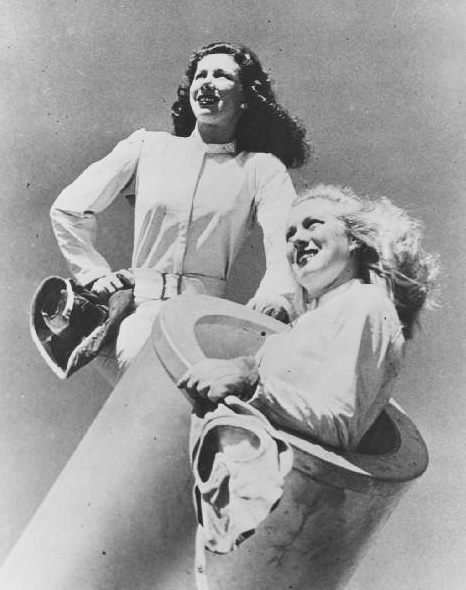
1945 Newspaper article:
https://news.google.com/newspapers?id=arUWAAAAIBAJ&sjid=JCMEAAAAIBAJ&pg=2807%2C346834



















